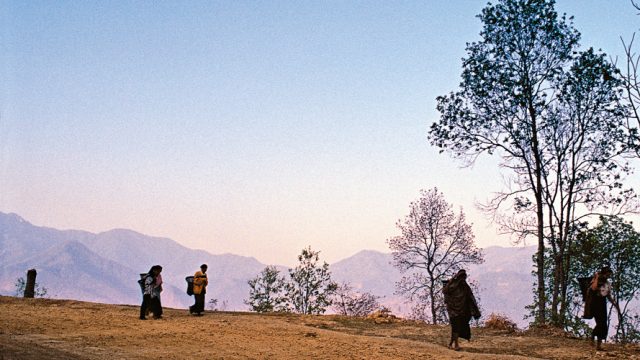The capital of Nagaland, Kohima, was built alongside the Angami Village of the same name by the British who arrived here in the 19th century. In the Angami language, Kewhima translates to “the land where the flower Kewhi grows”. Anglicised to Kohima by the British, the district of Kohima and the town that now serves as the capital of the state of Nagaland is a picture-perfect hill station, with serpentine roads across a series of ridges and hilltops.
Though the town is usually a relaxing stopover for the many trekkers that head to the south, and a tourist attraction for people from all over the world who come here to enjoy the Hornbill Festival, its historical importance means that there’s still a lot to see and do here.
Kohima is spread over many hills and ridges, and is navigable solely by car or motorcycle. Large public transport is unheard of, and trudging up and down the town won’t get you very far if you’ve got limited sightseeing time. Hire a cab for the day to make the most of it.

Things to See & Do
Kohima has everything going for it– from lovely weather and views to charming, friendly locals. You can easily spend a few days exploring the city. The traffic can get quite crazy though, so be prepared to be held up at various points. It’s also worth remembering that Sunday is truly a holiday here – everything, except hotels and eateries, is closed.
War Cemetery
A garden of space and serenity in the middle of the urban sprawl and traffic jams that have come to define busy Kohima, the War Cemetery has become as much a place of respite as a historical outing. This well-maintained space contains the gravestones of nearly 1,500 Indian, British and Commonwealth soldiers who died during the brief three-month Battle of Kohima, which is said to have taken the lives of over 10,000 soldiers. A memorial to the 2nd Division near the entrance bears the famous inscription:
When you go home,
Tell them of us and say,
For your tomorrow,
We gave our today.
The cemetery is located at the junction of the two roads that lead to Dimapur and Imphal respectively.
Entry Free Timings Summer: 8.00am–4.00pm; Winter: 8.00am–3.00pm
Kohima State Museum
The Kohima State Museum is a well-laid-out microcosm of the culture and history of Nagaland. Exhibits include tribal artefacts, jewellery, dioramas of women and men from the different Naga tribes, miniature depictions of the different houses and traditional huts across Nagaland, weapons, tools etc. It also includes a display of human skulls from the days of headhunting. The small museum is a simple, yet wonderful, representation of the richness and variety of cultures that comprise the land of Nagaland.
Entry ₹5 Timings 10.00am–5.00pm Closed Sundays and public holidays Photography Mobile ₹10; Still ₹20 Videography ₹100

Catholic Cathedral
This structurally interesting building houses what is said to be the largest cathedral in the Northeast. The interior is cavernous, with enough seating space for all 1,500 of its parishioners. Stop by for mass here if you are so inclined, and you will feel very much at peace.
Where to Stay & Eat
December can be impossibly busy and expensive, so book your dates as early as possible. Hotel Japfu (Tel: 0370-2240211-13; Tariff: ₹3,252–7,588) is the biggest and the best. Hotel Vivor (Tel: 2806243; Tariff: ₹3,360–9,864) is a luxury option with a restaurant and Wi-Fi, as is Hotel Legacy (Cell: 08415922086; Tariff: ₹3,794–8,672). Classic Aradura Inn (Tel: 2241079, Cell: 08119890194: Tariff: ₹2,200–4,950) is a great mid-range choice with beautifully furnished rooms, gorgeous wooden floors and furniture, and snug beds.
The Heritage (Cell: 09436215259; Tariff: ₹2,500–3,500) is a heritage bungalow with modern amenities. It was once the commissioner’s residence. Hotel Cimorb (Tel: 2242248; Tariff: ₹2,000–6,000) and Dimori Cove Resort (Cell: 08575494111; Tariff: ₹1,500–3,500) are also good options.
The Classic Aradura’s restaurant serves lovely north Indian and Chinese food, with some Naga specialties. Good local food options include Chungtsuong at Razhu Point and The Hut opposite the post office. Cafés include the lovely Brewberry Café on High School Road, and Café Caffeine above Jasokie Place in the main town.
Around Kohima
Tuophema (40km)
As you head deep into northern Angami territory, the lives of the Nagas unfold. At the Tuophema Tourist Village, a traditional welcome gate leads to the village, dominated by a large tree called the War Head Tree, where enemy heads were once hung as war trophies. The tourist village is run and maintained by a team of young locals and overseen by the elected village council. The tranquil tourist village offers a peaceful retreat, cultural and educational programmes, a local museum, as well as guided walks through the village.
Things to See & Do
With just over 500 families, this is a tightly-knit village. A guided walk around the village, arranged by the helpful staff at the tourist village, will take you past the old and new sections of the village, which include Baptist churches, an amphitheatre and a charming, although unoccupied, house built in the memory of the village founder. A museum displays Angami dresses, headdresses, weapons and jewellery along with household and ritual items relevant to this area. The gazebo near the dining room has lovely wooden seats from where visitors can enjoy the crisp mountain air, stunning views of the valleys and mountains for miles and miles and the most spectacular sunsets and sunrises you are likely to ever see.
Where to Stay & Eat
The Tourist Village (Cell: 09436832075, 08014926733; Tariff: ₹1,800 for single and ₹2,300 for a double occupancy hut) comprises 12 huts, all built by different clans in the villages. The spacious huts come with attached bathrooms. Simplicity and comfort are the key elements here. The young locals who maintain the tourist village also serve up some delicious Naga grub for their guests (approximately ₹250–350 per person per meal). Expect delicious home-made dal, pork, chicken and vegetable dishes at the buffet.




